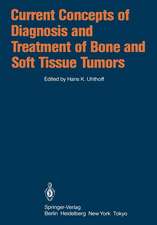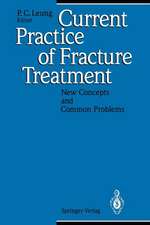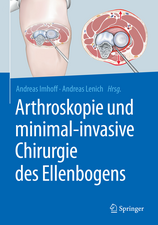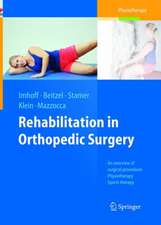Shoulder Instability Across the Life Span
Editat de Andreas B. Imhoff, Felix H. Savoie IIIen Limba Engleză Hardback – 18 mai 2017
| Toate formatele și edițiile | Preț | Express |
|---|---|---|
| Paperback (1) | 781.29 lei 38-44 zile | |
| Springer Berlin, Heidelberg – 29 iul 2018 | 781.29 lei 38-44 zile | |
| Hardback (1) | 859.82 lei 22-36 zile | |
| Springer Berlin, Heidelberg – 18 mai 2017 | 859.82 lei 22-36 zile |
Preț: 859.82 lei
Preț vechi: 905.08 lei
-5% Nou
Puncte Express: 1290
Preț estimativ în valută:
164.52€ • 172.24$ • 136.13£
164.52€ • 172.24$ • 136.13£
Carte disponibilă
Livrare economică 17-31 martie
Preluare comenzi: 021 569.72.76
Specificații
ISBN-13: 9783662540763
ISBN-10: 3662540762
Pagini: 273
Ilustrații: VII, 307 p. 115 illus., 95 illus. in color.
Dimensiuni: 178 x 254 mm
Greutate: 0.86 kg
Ediția:1st ed. 2017
Editura: Springer Berlin, Heidelberg
Colecția Springer
Locul publicării:Berlin, Heidelberg, Germany
ISBN-10: 3662540762
Pagini: 273
Ilustrații: VII, 307 p. 115 illus., 95 illus. in color.
Dimensiuni: 178 x 254 mm
Greutate: 0.86 kg
Ediția:1st ed. 2017
Editura: Springer Berlin, Heidelberg
Colecția Springer
Locul publicării:Berlin, Heidelberg, Germany
Cuprins
The Young patient with shoulder instability ( age < 20): Overview of the Spectrum of instability in the very young: Evolving concepts.- Classification of shoulder instability.- Genetics of the unstable shoulder.- Laxity vs MDI/Posterior in the young patient: Scapular dyskinesia.- Management of Acute Shoulder instability. The Young athletic high risk patient with Shoulder Instability (age 18-30): Spectrum of instability in the athletic young adult.- Overview of Evaluation and management of the unstable shoulder with and without bone loss: Definition, measurement, guidelines on treatment.- Arthroscopic soft tissue repair: Bankart + remplissage.- Open stabilization: Bankart repair / capsular shift / interval closure.- HAGL and RAGHL.- Bone Block techniques.- Symptomatic Posterior Instability: Evaluation and management.- Instability in the Middle ages 25-50: Spectrum of instability in the middle age range.- Bankart + RCT.- SLAP.- Biceps injuries: what to do and where.- Subscap tears and instability.- Arthritis. Instability in the “older” patient (Age > 50): Spectrum of instability in the older patient.- Acute RCT as a part of dislocation and acute dislocation superimposed on chronic RCT.- Dislocation arthropathy of the shoulder. Miscellaneous instability topics in the various ages: Combined lesions.- Glenoid fracture.- Locked posterior.- Locked anterior ( chronic).- Brachial plexus injuries and rotator cuff tears with dislocations. Complications: Complication after instability surgery.- Evaluation of failed instability surgery.
Recenzii
“This book addresses shoulder instability of all types and in all age groups, with a strong surgical emphasis. … This book is intended for orthopedic surgeons who deal with shoulder instability. It is appropriate for attending (consultant) orthopedists as well as those in training.” (Scott Magnes, Doody's Book Reviews, October, 2017)
Notă biografică
Andreas B. Imhoff, MD, is Professor of Orthopaedic Surgery and Chairman/Director of the Department of Orthopaedic Sports Medicine at the Technical University Munich (TUM), Hospital Rechts der Isar, Munich, Germany. He is a past President and General Secretary of the German Society of Arthroscopy and Joint Surgery (AGA) and will be the AGA Congress Chairman in the year 2016–7. He has also served on the executive boards of the German Society of Orthopaedics and Orthopaedic Surgery (for almost 20 years) and the German Society of Orthopaedics and Traumatology since 2009. Professor Imhoff is current Chairman of the ISAKOS Shoulder Committee. He has been the recipient of a number of awards and Honorary Membership (AANA, AGA, BuenosAires, Chile, India, Malaysia) and regularly appears in the Focus Toplist of Shoulder and Knee Surgeons, receiving maximum points. He is a member of the editorial boards of several leading journals and Editor-in-Chief of Arthroskopie and the Open AccessJournal of Sports Medicine. He is the author of more than 300 papers cited in PubMed and author or editor of 32 books.
Felix H. “Buddy” Savoie III, MD, is Ray J. Haddad Professor of Orthopaedics, Professor of Clinical Orthopaedics, and Chairman of the Department of Orthopaedics at Tulane University School of Medicine, New Orleans, LA, USA. He is also Chief, Division of Sports Medicine and Director of the Tulane Institute of Sports Medicine. Professor Savoie is a Past President of the Arthroscopy Association of North America and in 2015 served as First Vice President of American Shoulder and Elbow Surgeons. He is a member of the ISAKOS Board of Directors and current Deputy Chair of the ISAKOS Shoulder Committee. Professor Savoie has been the recipient of various honors and awards. He has undertaken many visiting professorships and is a board examiner for the American Board of Orthopaedic Surgeons (ABOS). He is an editorial board member or reviewer for a number of leading journals in the field and is the author of numerous papers in peer-reviewed journals as well as the editor or author of eight previous books.
Textul de pe ultima copertă
This book outlines the consensus findings of the ISAKOS Upper Extremity Committee regarding the treatment options for patients suffering from shoulder instability. The aim is to furnish readers with a precise knowledge of the presenting features of conditions typical of different ages, thereby facilitating assessment of patient characteristics and optimal treatment decision making based on the consensus of the Committee. All age groups are covered, from the very young through to the older patient. The structuring of the book essentially according to age group reflects the fact that certain forms of shoulder instability are observed at different ages. For example, while young patients tend to demonstrate instability combined with hyperlaxity, in later years, bony defects of the glenoid and humerus gain in importance. Similarly, the scope for conservative treatment varies across the life span. Each management-oriented chapter of the book includes information and guidance on anatomy, clinical examination, imaging, surgical indications and technique, rehabilitation, outcomes, and complications and their avoidance, and the text is supported by numerous high-quality illustrations.
Caracteristici
Presents the consensus findings of the ISAKOS Upper Extremity Committee regarding treatment options for patients suffering from shoulder instability Identifies the characteristic features of conditions typical of different ages Provides extensive information and guidance on all aspects of management for different presentations





















